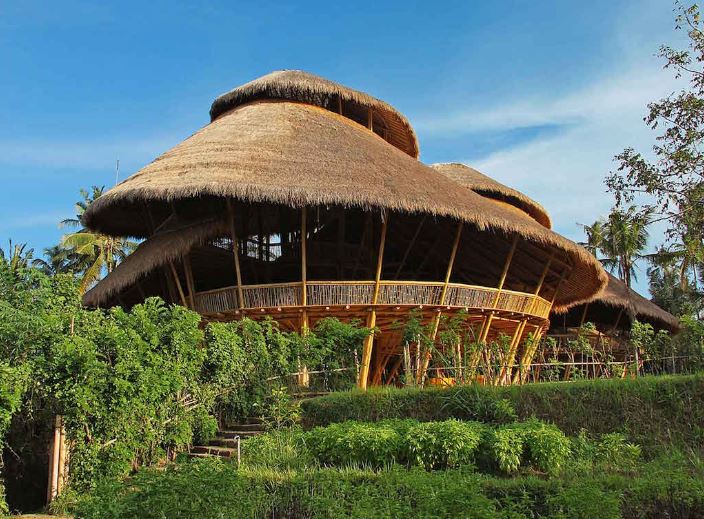Can bamboo be used to build structures?

Bamboo is a plant that grows quickly and can be harvested in a few years. This makes it an efficient and environmentally friendly option, especially compared to slower growing wood.
Known for its strength and durability, bamboo is as strong as steel and can withstand high stresses and loads. This makes it ideal for a variety of structural applications, from homes to bridges and temporary structures. Its flexibility is also a valuable attribute, allowing it to be used in various architectural forms and designs.
In this article from Bamboo Co, we will explore the use of bamboo in structures, highlighting its advantages and applications in construction.
Advantages of Bamboo in Structures
Bamboo is a building material that offers numerous advantages, making it increasingly popular in architecture and engineering.
Below we bring to you some of the advantages of bamboo in the most common structures:
Sustainability: Bamboo is a renewable resource that grows rapidly, with some species able to reach their maximum size in just a few months. This makes it an environmentally friendly option, as its cultivation and use has a lower environmental impact compared to other construction materials, such as wood or steel.
Strength: Bamboo is particularly strong and durable. Its tensile strength is comparable to that of steel, making it ideal for structural applications. This resistance, combined with its lightness, makes it an efficient material for construction.
Flexibility: Bamboo is a versatile and flexible material, allowing it to be used in a wide variety of structures. Its ability to bend and adapt to different architectural shapes and designs is a significant advantage, allowing architects and builders to be creative with its use.
Lightness: Despite its strength, bamboo is lightweight, making it easy to transport and handle on the construction site. This also reduces transportation costs and makes it easier to work with on construction projects.
Aesthetics: Bamboo has a natural, warm visual appeal that is appreciated in architecture. Its unique and elegant appearance adds an aesthetic element to structures, making it popular not only for its functional properties, but also for its ability to enhance the aesthetic of a building.
Cost Effective: In many regions, bamboo is an affordable building material compared to other materials such as steel or concrete. Its low cost, combined with its durability and sustainability, makes it an economical choice for many construction applications.
Applications of Bamboo in Construction
Bamboo is a versatile and sustainable material that is used in many areas of construction, including:
- Homes: Bamboo is used in the construction of homes, both in complete structures and in structural and decorative elements. In countries such as India, China and Colombia, bamboo houses have been built that are floating, resistant and sustainable.
- Bridges: Bamboo has been used to build strong and durable bridges. For example, in countries such as Vietnam and China, impressive bamboo bridges can be found that demonstrate the strength and flexibility of this material, allowing local communities to cross rivers and streams.
- Temporary Structures: Bamboo is ideal for temporary structures, such as pavilions, stages and tents. At festivals and events, bamboo is popular due to its easy handling and quick assembly, as well as being eco-friendly. Examples include music stages and structures for cultural events.
- Public Buildings: Bamboo is used in public and commercial buildings, such as schools, community centres and offices. For example, the Green School in Bali is a recognized example of sustainable architecture that uses bamboo in its design. These buildings show how bamboo can be functional and aesthetic.
- Decoration: Bamboo is popular in interior design and decoration. It is used to create furniture, bamboo wall coverings, ceilings and decorative elements. Its natural and warm appearance makes it ideal for adding a touch of elegance and sustainability to indoor or outdoor spaces.
Challenges and Considerations of Bamboo as a Construction Material
Bamboo is a building material with many advantages, but it also presents some important challenges and considerations:
Durability: Bamboo, as a natural material, needs proper treatment to ensure its durability. Without proper treatment and maintenance, it can be susceptible to deterioration, which affects its useful life.
It is recommended to treat bamboo with preservatives and keep it protected from excessive exposure to the elements.
Humidity and Termites: Bamboo is sensitive to humidity and termite attacks. It is crucial to protect it from excessive humidity and treat it against pests to prevent degradation.
In humid climates, bamboo can develop mould if not properly ventilated. Preventive treatments and proper design can mitigate these problems.
Regulations: The use of bamboo in construction is subject to regulations and standards that vary by region. In some places, regulations for the use of bamboo are not well defined, which can complicate its application in construction projects. It is important to be aware of local regulations and ensure that the bamboo meets quality standards.
Discover how bamboo’s unique properties can revolutionize your construction projects! Dive into our website to explore innovative bamboo structures and their sustainable benefits!